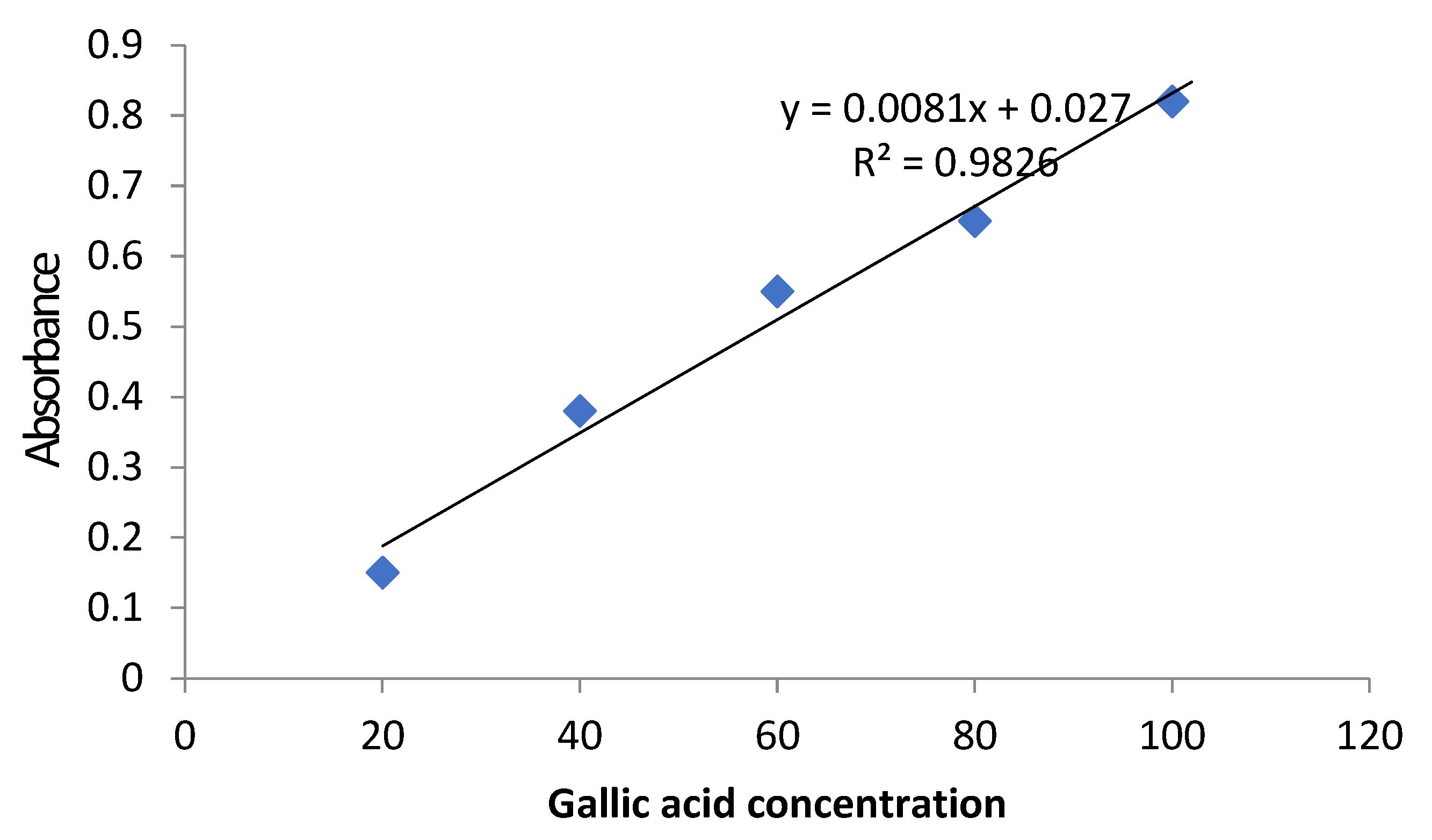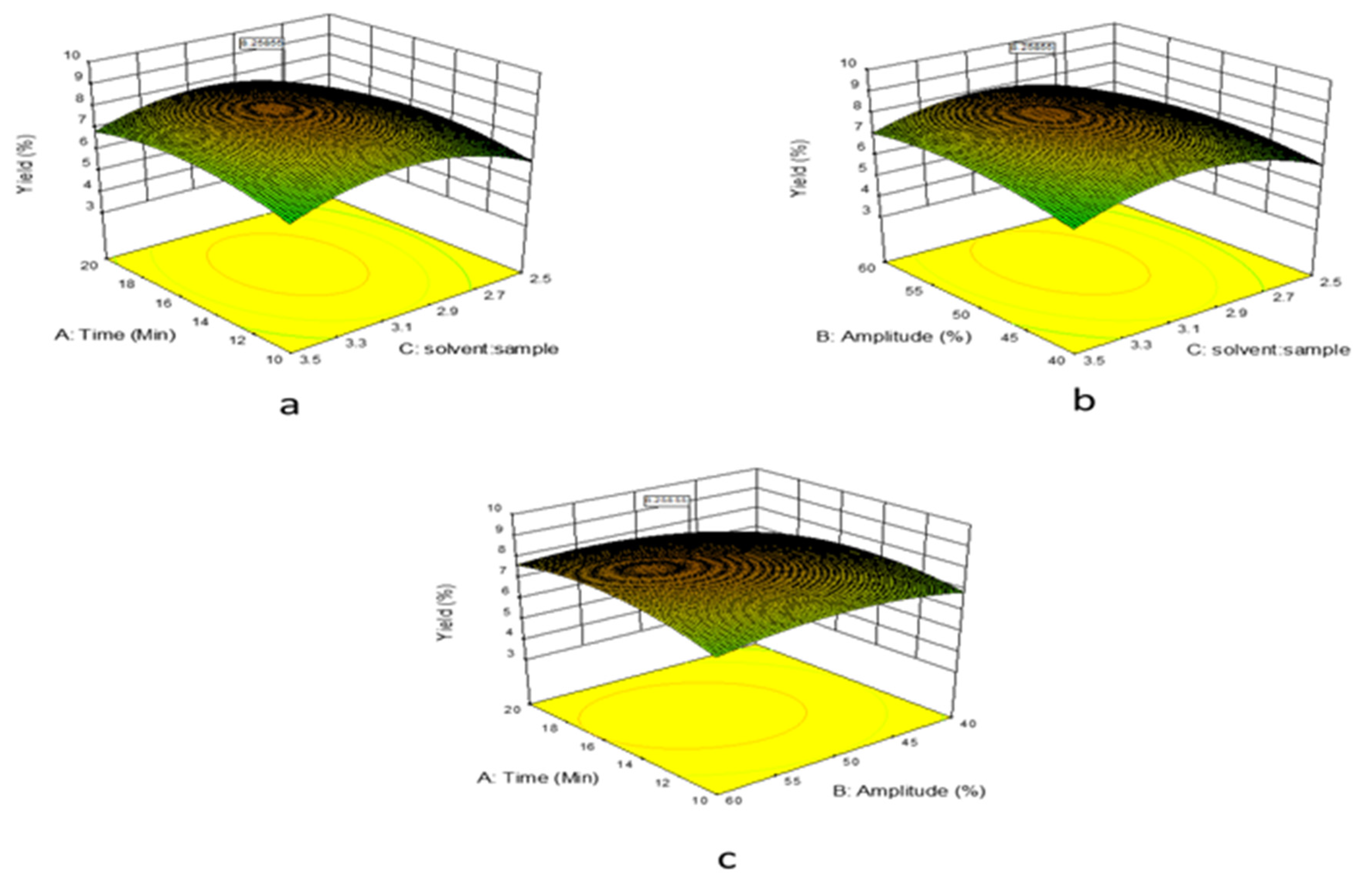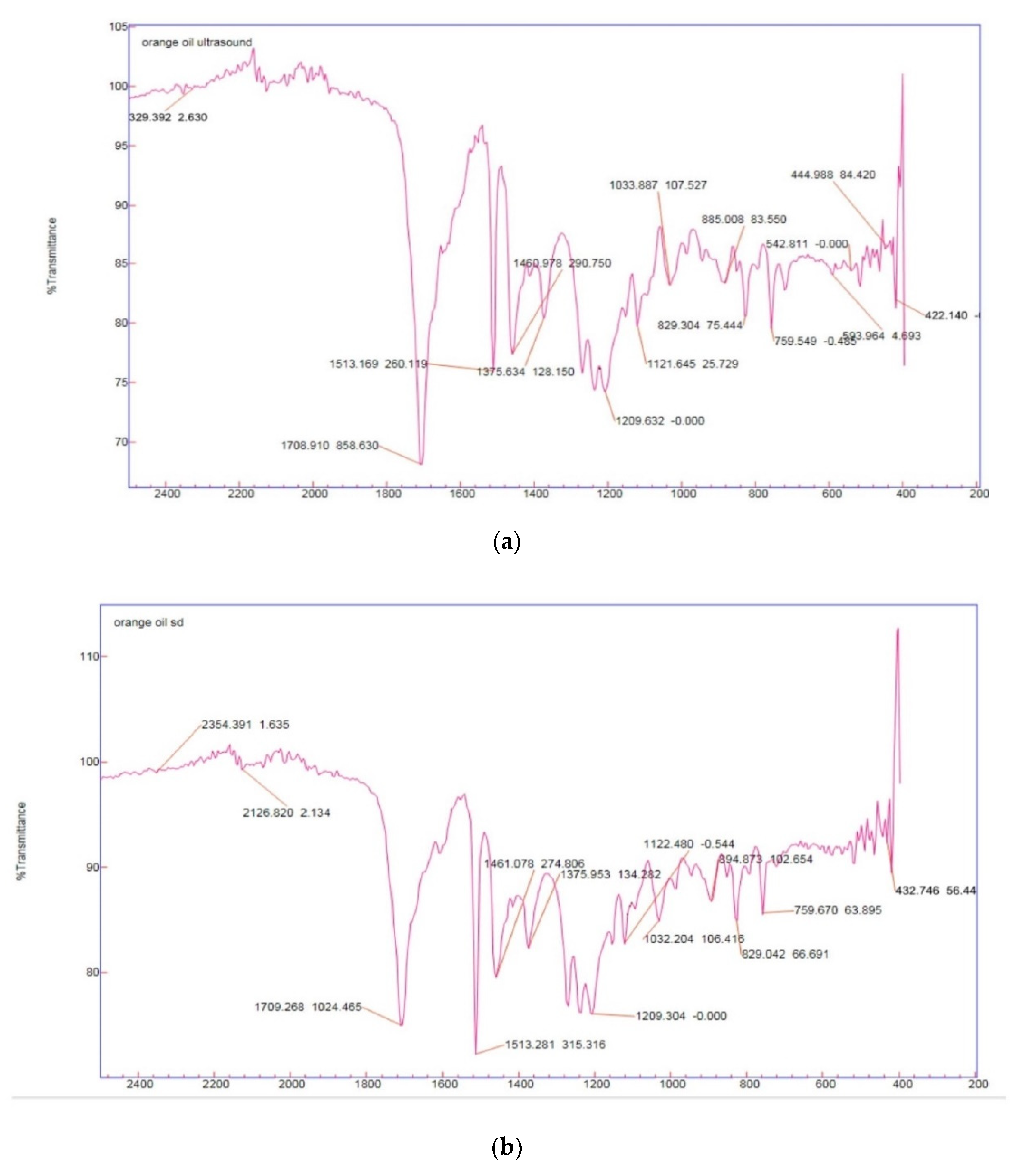Effect of Ultrasound-Assisted Pretreatment on Extraction Efficiency of Essential Oil and Bioactive Compounds from Citrus Waste By-Products
Abstract
1. Introduction
2. Materials and Methods
2.1. Chemical Reagents
2.2. Materials
2.3. Experimental Design and Statistical Analysis
2.4. Ultrasound-Assisted Extraction (UAE)
2.5. Hydro-Distillation
2.6. Quantitative Phytochemical Analysis
2.6.1. Total Phenolic Content (TPC)
2.6.2. Antioxidant Activity (DPPHAssay)
2.7. FourierTransform Infrared (FT-IR) Analysis
2.8. Gas Chromatography Mass Spectrometry (GCMS) Analysis of Citrus EO
2.9. High Performance Liquid Chromatography (HPLC) Analysis of Phenolic Compounds
2.10. Statistical Analysis
3. Resultsand Discussions
3.1. Experimental Design Matrix
3.2. Effect on the Extraction Yield
3.3. Extraction of Oil
3.4. Fourier Transform Infra-Red (FTIR) Analysis
3.5. Chemical Composition of Citrus EO by GCMS Analysis
3.6. Phytochemical Screening of Polyphenol Extract
3.6.1. Total Phenolic Content
3.6.2. DPPH Activity
3.7. HPLC Analysis
4. Conclusions
Author Contributions
Funding
Institutional Review Board Statement
Informed Consent Statement
Data Availability Statement
Acknowledgments
Conflicts of Interest
References
- Kumar, N.; Ojha, A.; Singh, R. Preparation and characterization of chitosan—Pullulan blended edible films enrich with pomegranate peel extract. React. Funct. Polym. 2019, 144, 104350. [Google Scholar] [CrossRef]
- Mahato, N.; Sharma, K.; Sinha, M.; Baral, E.R.; Koteswararao, R.; Dhyani, A.; Hwan Cho, M.; Cho, S. Bio-sorbents, industrially important chemicals and novel materials from citrus processing waste as a sustainable and renewable bioresource: A review. J. Adv. Res. 2020, 23, 61–82. [Google Scholar] [CrossRef]
- Kumar, N.; TrajkovskaPetkoska, A.; Khojah, E.; Sami, R.; Al-Mushhin, A.A. Chitosan Edible Films Enhanced with Pomegranate Peel Extract: Study on Physical, Biological, Thermal, and Barrier Properties. Materials. 2021, 14, 3305. [Google Scholar] [CrossRef] [PubMed]
- Kaur, K. Functional nutraceuticals: Past, present, and future. In Neutraceuticals; Grumezescu, A.M., Ed.; Academic Press: Cambridge, UK; Elsevier: London, UK, 2016; Volume 4, pp. 41–78. [Google Scholar]
- Manthey, J.A.; Grohmann, K. Phenolics in citrus peel byproducts. Concentrations of hydroxycinnamates and polymethoxylated flavones in citrus peel molasses. J. Agric. Food Chem. 2001, 49, 3268–3273. [Google Scholar] [CrossRef]
- Wang, L.; Wang, J.; Fang, L.; Zheng, Z.; Zhi, D.; Wang, S.; Zhao, H. Anticancer activities of citrus peel polymethoxyflavones related to angiogenesis and others. Biomed Res. Int. 2014, 2014, 453972. [Google Scholar] [CrossRef]
- Romagnolo, D.F.; Selmin, O.I. Flavonoids and cancer prevention: A review of the evidence. J. Nutr. Gerontol. Geriatr. 2012, 31, 206–238. [Google Scholar] [CrossRef] [PubMed]
- Meiyanto, E.; Hermawan, A.; Anindyajati, A. Natural products for cancer-targeted therapy: Citrus flavonoids as potent chemopreventive agents. Asian Pac. J. Cancer Prev. 2012, 13, 427–436. [Google Scholar] [CrossRef] [PubMed]
- Aruoma, O.I.; Landes, B.; Ramful-Baboolall, D.; Bourdon, E.; Neergheen-Bhujun, V.; Wagner, K.H.; Bahorun, T. Functional benefits of citrus fruits in the management of diabetes. Prev. Med. 2012, 54, S12–S16. [Google Scholar] [CrossRef]
- Hwang, S.L.; Shih, P.H.; Yen, G.C. Neuroprotective effects of citrus flavonoids. J. Agric. Food Chem. 2012, 60, 877–885. [Google Scholar] [CrossRef]
- Elhakem, A.H.; Benajiba, N.; Koko, M.Y.; Khojah, E.; Rok, A. DPPH, FRAP and TAEC Assays with Postharvest Cabbage (Brassica oleracea) Parameters During the Packaging Process. Pak. J. Agric. Sci. 2021, 24, 182–187. [Google Scholar] [CrossRef]
- El Tamer, M.K. Molecular Regulation of Plant Monoterpene Biosynthesis in Relation to Fragrance; 2002; Available online: https://edepot.wur.nl/121357 (accessed on 5 December 2021).
- Smith, D.C.; Forland, S.; Bachanos, E.; Matejka, M.; Barrett, V. Qualitative analysis of citrus fruit extracts by GC/MS: An undergraduate experiment. Chem. Educ. 2005, 6, 28–31. [Google Scholar] [CrossRef]
- Luque De Castro, M.D.; Jiménez-Carmona, M.M.; Fernández-Pérez, V. Towards more rational techniques for the isolation of valuable essential oils from plants. TrAC Trends Anal. Chem. 1999, 18, 708–716. [Google Scholar] [CrossRef]
- Lucchesi, M.E.; Chemat, F.; Smadja, J. Solvent-free microwave extraction of essential oil from aromatic herbs: Comparison with conventional hydro-distillation. J. Chromatogr. A. 2004, 1043, 323–327. [Google Scholar] [CrossRef]
- Zulkifli, K.S.; Abdullah, N.; Abdullah, A.; Aziman, N.; Kamarudin, W.S. Bioactive phenolic compounds and antioxidant activity of selected fruit peels. Int. Conf. Environ. Chem. Biol. 2012, 49, 66–70. [Google Scholar]
- Vilkhu, K.; Mawson, R.; Simons, L.; Bates, D. Applications and opportunities for ultrasound assisted extraction in the food industry—A review. Innov. Food Sci. Emerg. Technol. 2008, 9, 161–169. [Google Scholar] [CrossRef]
- Kumar, N.; Pratibha; Neeraj; Sharma, S. Effect of Solvents on Physiochemical Properties of Freeze-dried Pomegranate Seed (Cv. Bhagwa). Int. J. Fruit Sci. 2020, 20, 590–604. [Google Scholar] [CrossRef]
- Kumar, N.; Neeraj. Effect of Ultrasonic Assisted Extraction on the Properties of Freeze-Dried Pomegranate Arils. Curr. Nutr. Food Sci. 2020, 16, 83–89. [Google Scholar] [CrossRef]
- Chemat, F.; Zill-e-Huma; Khan, M.K. Applications of ultrasound in food technology: Processing, preservation and extraction. Ultrason. Sonochem. 2011, 18, 813–835. [Google Scholar] [CrossRef] [PubMed]
- Vinatoru, M. An overview of the ultrasonically assisted extraction of bioactive principles from herbs. Ultrason. Sonochem. 2001, 8, 303–313. [Google Scholar] [CrossRef]
- Cameron, M.; McMaster, L.D.; Britz, T.J. Impact of ultrasound on dairy spoilage microbes and milk components. Dairy Sci. Technol. 2010, 90, 119. [Google Scholar] [CrossRef][Green Version]
- Reverchon, E.; Ambruosi, A.; Senatore, F. Isolation of Peppermint Oil Using Supercritical CO2. Flavour Fragr. J. 1994, 9, 19–23. [Google Scholar] [CrossRef]
- Li, H.; Pordesimo, L.; Weiss, J. High intensity ultrasound-assisted extraction of oil from soybeans. Food Res. Int. 2004, 37, 731–738. [Google Scholar] [CrossRef]
- Zhang, Z.-S.; Wang, L.-J.; Li, D.; Jiao, S.-S.; Chena, Z.-H.M. Ultrasound-assisted extraction of oil from flaxseed. Sep. Purif. Technol. 2008, 62, 192–198. [Google Scholar] [CrossRef]
- Sikdar, D.C.; Menon, R.; Duseja, K.; Kumar, P.; Swami, P. Extraction of citrus oil from orange (Citrus sinensis) peels by steam distillation and its characterizations. Int. J. Tech. Res. Appl. 2016, 4, 2320–8163. [Google Scholar]
- Harborne, J.B. Phytochemical Methods a Guide to Modern Techniques of Plant Analysis, 5th ed.; Chapman and Hall Ltd.: London, UK, 1998. [Google Scholar]
- Fawole, O.A.; Opara, U.L.; Theron, K.I. Chemical and Phytochemical Properties and Antioxidant Activities of Three Pomegranate Cultivars Grown in South Africa. Food Bioprocess Technol. 2012, 5, 2934–2940. [Google Scholar] [CrossRef]
- Elhakem, A.H.; Almatra, M.M.; Benajiba, N.; Koko, M.Y.; Sami, R. Comparative Analysis of Bioactive Compounds, Antioxidant and Anti-inflammatory Activities of Apple Varieties. Asian J. Plant Sci. 2020, 20, 61–66. [Google Scholar] [CrossRef]
- Sami, R.; Khojah, E.; Mansour, A.M.A.; Al-Mushhin, A.A.M.; Elhakem, A.; El-Sherif, D.M.; Alkaltham, M.S.; Salamatullah, A.M. Nutritional Values, Microbial Population and Bioactive Components of Pomegranate (Punicagranatum L.) Peel Extracts. Int. J. Pharmacol. 2021, 17, 208–216. [Google Scholar] [CrossRef]
- Alkaltham, M.S.; Hayat, K.; Ahmed, M.A.; Salamatullah, A.M.; Sami, R.; Khojah, E.; Al-Mushhin, A.A.M. Bioactive Compounds, HPLC Screening of Phenolic Compounds and Antioxidant Potential Activity of Saffron(Crocus Sativus L.). J. Biobased Mater. Bioenergy. 2021, 15, 1–5. [Google Scholar]
- Fakayode, O.A.; Abobi, K.E. Optimization of oil and pectin extraction from orange (Citrus sinensis) peels: A response surface approach. J. Anal. Sci. Technol. 2018, 9, 1–16. [Google Scholar] [CrossRef]
- Giwa, S.O.; Muhammad, M.; Giwa, A. Utilizing orange peels for essential oil production. ARPN J. Eng. Appl. Sci. 2018, 13, 17–27. [Google Scholar]
- Medina-Torres, N.; Ayora-Talavera, T.; Espinosa-Andrews, H.; Sánchez-Contreras, A.; Pacheco, N. Ultrasound assisted extraction for the recovery of phenolic compounds from vegetable sources. Agronomy. 2017, 7, 47. [Google Scholar] [CrossRef]
- Assami, K.; Pingret, D.; Chemat, S.; Meklati, B.Y.; Chemat, F. Ultrasound induced intensification and selective extraction of essential oil from Carumcarvi L. seeds. Chem. Eng. Process. Process Intensif. 2012, 62, 99–105. [Google Scholar] [CrossRef]
- Morsy, N.F.S. A short extraction time of high quality hydrodistilled cardamom (Elettaria cardamomum L. Maton) essential oil using ultrasound as a pretreatment. Ind. Crops Prod. 2015, 65, 287–292. [Google Scholar] [CrossRef]
- Toan, T.Q.; Truc, T.T.; Le, X.T.; Quyen, N.T.; Tran, T.H. Study on extraction process and analysis of components in essential oils of Vietnamese orange peel (Citrus sinensis) by microwave assisted hydrodistillation extraction. In IOP Conference Series: Materials Science and Engineering 2020; IOP Publishing: Bristol, UK, 2020; Volume 991, p. 012125. [Google Scholar] [CrossRef]
- Yang, E.J.; Kim, S.S.; Oh, T.H.; Baik, J.S.; Lee, N.H.; Hyun, C.G. Essential oil of citrus fruit waste attenuates LPS-induced nitric oxide production and 272 inhibits the growth of skin pathogens. Int. J. Agri. Biol. 2009, 11, 791–794. [Google Scholar]
- Ferhat, M.A.; Meklati, B.Y.; Smadja, J.; Chemat, F. An improved microwave Clevenger apparatus for distillation of essential oils from orange peel. J. Chromatogr. A. 2006, 1112, 121–126. [Google Scholar] [CrossRef]
- Azhdarzadeh, F.; Hojjati, M. Chemical Composition and Biological Activities of Lemon (Citrus limon) Leaf Essential Oil. Nutr. Food Sci. Res. 2017, 3, 43–50. [Google Scholar]
- Sarrou, E.; Chatzopoulou, P.; Theriou, K.; Therios, I. Volatile Constituents and Antioxidant Activity of Peel, Flowers and Leaf Oils of Citrus aurantium L. Growing in Greece. Molecules. 2013, 18, 10639–10647. [Google Scholar] [CrossRef] [PubMed]
- Luximon-Ramma, A.; Bahorun, T.; Crozier, A. Antioxidant actions and phenolic and vitamin C contents of common Mauritian exotic fruits. J. Sci. Food Agric. 2003, 83, 496–502. [Google Scholar] [CrossRef]
- Nayak, B.; Dahmoune, F.; Moussi, K.; Remini, H.; Dairi, S.; Aoun, O.; Khodir, M. Comparison of microwave, ultrasound and accelerated-assisted solvent extraction for recovery of polyphenols from Citrus sinensis peels. Food Chem. 2015, 187, 507–516. [Google Scholar] [CrossRef]
- Arnao, M.B.; Cano, A.; Acosta, M. The hydrophilic and lipophilic contribution to total antioxidant activity. Food Chem. 2001, 73, 239–244. [Google Scholar] [CrossRef]
- Park, J.H.; Lee, M.; Park, E. Antioxidant activity of orange flesh and peel extracted with various solvents. Prev. Nutr. Food Sci. 2014, 19, 291. [Google Scholar] [CrossRef] [PubMed]
- Malik, A.; Czech, A.; Sosnowska, B.; Domaradzki, P. Bioactive Substances, Heavy Metals, and Antioxidant Activity in Whole Fruit, Peel, and Pulp of Citrus Fruits. Int. J. Food Sci. 2021, 2021. [Google Scholar] [CrossRef]
- Ma, Y.Q.; Chen, J.C.; Liu, D.H.; Ye, X.Q. Simultaneous extraction of phenolic compounds of citrus peel extracts: Effect of ultrasound. Ultrason. Sonochem. 2009, 16, 57–62. [Google Scholar] [CrossRef] [PubMed]
- Khan, M.K.; Abert-Vian, M.; Fabiano-Tixier, A.S.; Dangles, O.; Chemat, F. Ultrasound-assisted extraction of polyphenols (flavanone glycosides) from orange (Citrus sinensis L.) peel. Food Chem. 2010, 119, 851–858. [Google Scholar] [CrossRef]



| Variables | −α | −1 | 0 | +1 | +α | |
|---|---|---|---|---|---|---|
| Extraction Time (mins) | A | 5 | 10 | 15 | 20 | 25 |
| Amplitude (%) | B | 30 | 40 | 50 | 60 | 70 |
| Solvent/sample ratio | C | 2/1 | 2.5/1 | 3/1 | 3.5/1 | 4/1 |
| Run | Extraction Time A, min | Amplitude of Ultrasound B, % | Solvent: Sample (C) | Yield % Expt. | Yield % Predict |
|---|---|---|---|---|---|
| 1 | 5 | 50 | 3:1 | 5.54 | 5.40 |
| 2 | 15 | 70 | 3:1 | 6.62 | 6.60 |
| 3 | 15 | 50 | 3:1 | 8.33 | 8.12 |
| 4 | 25 | 50 | 3:1 | 6.82 | 8.94 |
| 5 | 15 | 50 | 2:1 | 5.20 | 5.26 |
| 6 | 10 | 60 | 2.5:1 | 5.89 | 5.78 |
| 7 | 15 | 50 | 4:1 | 3.91 | 3.90 |
| 8 | 20 | 40 | 3.5:1 | 5.67 | 5.63 |
| 9 | 15 | 50 | 3:1 | 8.96 | 8.91 |
| 10 | 15 | 50 | 3:1 | 8.20 | 8.16 |
| 11 | 10 | 60 | 3.5:1 | 6.60 | 6.63 |
| 12 | 10 | 40 | 3.5:1 | 6.75 | 6.82 |
| 13 | 10 | 40 | 2.5:1 | 5.15 | 5.18 |
| 14 | 15 | 50 | 3:1 | 8.33 | 8.32 |
| 15 | 15 | 50 | 3:1 | 8.10 | 8.07 |
| 16 | 15 | 30 | 3:1 | 6.41 | 6.44 |
| 17 | 20 | 60 | 3.5:1 | 7.67 | 7.65 |
| 18 | 15 | 50 | 3:1 | 7.40 | 7.43 |
| 19 | 20 | 60 | 2.5:1 | 5.43 | 5.43 |
| 20 | 20 | 40 | 2.5:1 | 5.20 | 5.26 |
| Peak No. | Compound Name | Retention Time | Area% |
|---|---|---|---|
| 1 | Pinene beta | 1.842 | 2.30 |
| 2 | Pinene alpha | 2.400 | 0.22 |
| 3 | Bicyclo[3.1.0]hexane, 4-methylene-1-(1-methylethyl) | 2.492 | 2.02 |
| 4 | 3-Carene | 2.706 | 0.47 |
| 5 | Myrcene beta | 2.807 | 4.82 |
| 6 | Limonene | 3.278 | 58.48 |
| 7 | Cymene para | 3.754 | 0.34 |
| 8 | Octanal | 3.906 | 0.59 |
| 9 | Nonanal | 4.825 | 0.15 |
| 10 | cis-(-)-1,2-Epoxy-p-menth-8-ene | 5.309 | 4.57 |
| 11 | Limonene oxide, trans | 5.416 | 3.25 |
| 12 | Cis Limonene oxide | 5.475 | 0.18 |
| 13 | Linalool | 6.100 | 1.75 |
| 14 | 1-Octanol | 6.178 | 0.27 |
| 15 | Limona ketone | 6.216 | 1.19 |
| 16 | Copaene beta | 6.532 | 0.28 |
| 17 | trans-p-Mentha-2,8-dienol | 6.795 | 1.97 |
| 18 | 1-Nonanol | 7.008 | 0.16 |
| 19 | Citral-Cis | 7.135 | 1.79 |
| 20 | Citral (Gernial) trans | 7.644 | 0.22 |
| 21 | (-)-Carvone | 7.694 | 2.43 |
| 22 | Trans-Mentha-2,8-dien-1-ol | 7.795 | 1.21 |
| 23 | Citronellol | 7.830 | 0.16 |
| 24 | p-Acetyltoluene | 8.162 | 0.15 |
| 25 | 2-Cyclohexen-1-ol, 2-methyl-5-(1-methylethenyl)-, cis | 8.388 | 3.02 |
| 26 | Citronellylacetone | 8.461 | 0.47 |
| 27 | 2-Cyclohexen-1-one, 3-methyl-6-(1-methylethenyl)-, (S) | 8.493 | 0.50 |
| 28 | Carveol | 8.611 | 2.57 |
| 29 | cis-p-mentha-1(7),8-dien-2-ol | 8.788 | 0.30 |
| 30 | Carveol trans | 8.945 | 0.18 |
| 31 | 5,7-Dimethyloctahydrocoumarin | 9.189 | 0.11 |
| 32 | Limonen-10-ol | 9.530 | 0.87 |
| 33 | Perilla alcohol | 9.947 | 0.93 |
| 34 | Octanoic acid | 10.367 | 0.65 |
| 35 | cis-p-Mentha-2,8-dien-1-ol | 10.543 | 0.47 |
| 36 | Nonanoic acid | 10.654 | 0.31 |
| 37 | Cyclooctanone | 11.177 | 0.20 |
| 38 | 2-hydroxy-2-methyl-4-heptanone | 11.328 | 0.15 |
| 39 | Limonen-1,2-diol | 12.107 | 0.29 |
| Sample | TPC (mg GAE/100 g) | DPPH (%) IC50 |
|---|---|---|
| Citrus sinensis Peel | 258.67 ± 1.14 | 44.26 ± 4.87 |
| Citrus sinensis Pulp | 735.54 ± 1.83 | 23.78 ± 3.53 |
| Mean ± SD (n = 3) | ||
| Bioactive Compound | Citrus sinesis Peel (mg/100 g DM) | Citrus sinesis Pulp (mg/100 g DM) | LoD (μg/g) | LoQ (μg/g) |
|---|---|---|---|---|
| Caffeic acid | 1.76 ± 0.04 c | 0.83 ± 0.01 b | 1.16 | 3.83 |
| Myrecitin | ND | ND | 1.12 | 3.70 |
| Hesperidin | 20.11 ± 0.38 d | 31.52 ± 0.53 e | 1.01 | 3.33 |
| Naringin | 3.63 ± 0.34 b | 3.12 ± 0.15 c | 1.20 | 3.96 |
| Vanillin | 1.21 ± 0.06 | ND | 1.19 | 3.93 |
| Kaempferol | 5.62 ± 0.61 a | 0.51 ± 0.05 a | 1.15 | 3.79 |
| Quercetin | 1.13 ± 0.05 a | 1.06 ± 0.02 a | 1.10 | 3.63 |
Publisher’s Note: MDPI stays neutral with regard to jurisdictional claims in published maps and institutional affiliations. |
© 2021 by the authors. Licensee MDPI, Basel, Switzerland. This article is an open access article distributed under the terms and conditions of the Creative Commons Attribution (CC BY) license (https://creativecommons.org/licenses/by/4.0/).
Share and Cite
Sandhu, H.K.; Sinha, P.; Emanuel, N.; Kumar, N.; Sami, R.; Khojah, E.; Al-Mushhin, A.A.M. Effect of Ultrasound-Assisted Pretreatment on Extraction Efficiency of Essential Oil and Bioactive Compounds from Citrus Waste By-Products. Separations 2021, 8, 244. https://doi.org/10.3390/separations8120244
Sandhu HK, Sinha P, Emanuel N, Kumar N, Sami R, Khojah E, Al-Mushhin AAM. Effect of Ultrasound-Assisted Pretreatment on Extraction Efficiency of Essential Oil and Bioactive Compounds from Citrus Waste By-Products. Separations. 2021; 8(12):244. https://doi.org/10.3390/separations8120244
Chicago/Turabian StyleSandhu, Harloveleen Kaur, Prachi Sinha, Neela Emanuel, Nishant Kumar, Rokayya Sami, Ebtihal Khojah, and Amina A. M. Al-Mushhin. 2021. "Effect of Ultrasound-Assisted Pretreatment on Extraction Efficiency of Essential Oil and Bioactive Compounds from Citrus Waste By-Products" Separations 8, no. 12: 244. https://doi.org/10.3390/separations8120244
APA StyleSandhu, H. K., Sinha, P., Emanuel, N., Kumar, N., Sami, R., Khojah, E., & Al-Mushhin, A. A. M. (2021). Effect of Ultrasound-Assisted Pretreatment on Extraction Efficiency of Essential Oil and Bioactive Compounds from Citrus Waste By-Products. Separations, 8(12), 244. https://doi.org/10.3390/separations8120244







